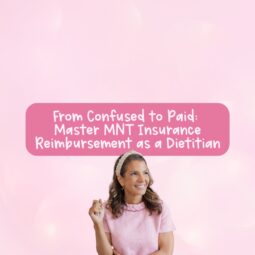Hey there, it’s Amy P., The Reimbursement Dietitian. This week, I want to share some real talk about a topic that makes most dietitians in private practice sweat: insurance audits.
You might think I’m immune to the stress of audits by now—trust me, I’m not. Even after going through this process many times, I still get that sinking-stomach feeling every time I receive the dreaded fax.
Most of our audits come from Anthem Blue Cross Blue Shield, and while I know they’re just doing their job, it never feels “easy.”
I’m writing this while we’re smack-dab in the middle of an audit—yes, one that landed during my vacation in Florida (because of course it did). So I thought now would be the perfect time to give you tips on handling insurance audits as a dietitian.
1. Know That Insurance Audits Are Inevitable (Not Punitive)
Insurance audits are part of doing business with insurance companies. They’re often random and used as part of internal checks and balances, not because you did anything wrong. The companies usually select a handful of patients at random.
2. What to Send in an Audit
They’re typically looking for:
- Your chart notes
- Any educational materials or resources you gave to patients (meal plans, handouts, etc.)
- Referrals (if applicable—but not always required)
Be sure your documentation is thorough and reflects the services provided. That’s your safety net.
3. Deadlines Are Tight—But Extensions Are Possible
You usually have 10–12 days to respond. However, in many cases, you can request a short extension. Don’t panic—just plan.
4. Don’t Freak Out—Most RDs Are Doing Just Fine
Many dietitians worry their notes won’t “pass.” But in my experience, most documentation is more than acceptable. If you’re unsure, I have a Documentation Master Class that explains precisely what to include to stay audit-ready.
5. Watch for Third-Party Requests
Medical record requests usually come from third-party companies like Inovalon or Ciox, not directly from the insurance company. Many RDs mistake these for scams, but they’re legit.
6. Submit Your Notes Safely
You can fax your notes or send them via a secure mail label provided by the audit company. Standard mail with a tracking label is often acceptable, and the company will typically cover shipping.
7. Expect a Mix of Patient Types
Auditors may request single-session notes, multi-session visits, or long-term patients seen weekly. That’s typical—don’t overthink it.
Bonus Resources
👉 Want help streamlining your charting process? Some coaching clients created a tutorial on using AI software like Heidi for easier documentation. Click [insert YouTube video on AI Charting] to check it out.
👉 Need help preparing for audits? I offer two Master Classes—one on documentation and one on insurance audits—where I show you what I’ve submitted and how the process works step-by-step.



Reader Interactions